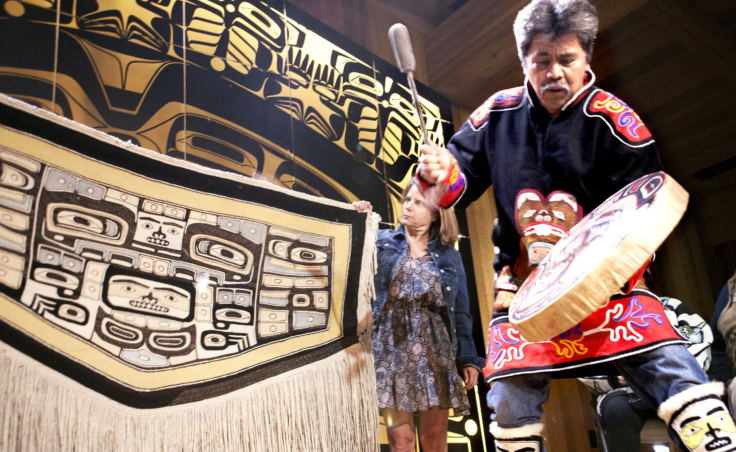Southeast Alaska tribes celebrated the return of a long lost ancestor Saturday, when a Seattle couple donated back a hundred-plus-year-old sacred Chilkat robe.
Drumming, dancing and telling stories over an afternoon, representatives from three Southeast Alaska tribes celebrated the return of their Chilkat blanket. Tlingit, Haida and Tsimshian members held a homecoming ceremony in the Shuká Hit clan house in Juneau.
For more than 20 years, the sacred object hung on the wall in the Seattle home of Bruce and Gretchen Jacobsen. Gretchen said her husband bought the blanket from a store in Seattle’s Pioneer Square.
“Bruce saw the blanket, robe, and he fell in love with it and brought it home,” she said.
Although Bruce Jacobsen said the couple had the robe authenticated, not much is known about its history before he bought it.
One of their daughters, Sara, was reading an art history text book and found a picture of a Chilkat robe. Recognizing the similarities between the picture and the robe that hung on her family’s wall, she began researching. When Sara learned of its sacred ceremonial significance, she insisted the family was trespassing on traditional Native culture.
The couple reached out to the University of Washington’s Burke Museum. Later, they contacted Rosita Worl at Sealaska Heritage Institute, where they eventually donated the robe.
The couple came to Juneau as guests at the homecoming ceremony.
Commenting on the story of the blanket, several speakers say that the family is integrated into the story of the robe forever. That’s something that stuck with Gretchen Jacobsen.
“One person … had said … The weave is representative of how everyone is connected and everyone’s related and we’re all part of the whole picture. It was a beautiful thing.”
She said she may never look at Native artwork the same.
“It made me think of all the different art forms you see in museums and you think ‘Wow, those are peoples’ ancestors and spirits within these pieces.’”
Yeilnaau Joe Zuboff calls for the spirits of the Chilkat robe to come home.
“I tried to put in some, back the spirit, that, we believe everything has a spirit,” he said. “Today is a big part of our history now, so part of the history of that blanket that returned is happy history that comes back.”
Zuboff represents Raven house in Angoon. He’s also a caretaker for their at.óowu, or sacred clan objects. Many Southeast Alaska Natives believe their sacred objects are imbued with the spirits of their ancestors associated with the items.
Tlingit elder and artist Kinkaduneek Paul Marks thinks those ancestors had a role influencing Sara Jacobsen.
“What took place today is as if our ancestors returned home to us. And the way it appears and sounds like to me is the young lady who talked to her mom and dad she heard the voice of our ancestors and the blanket wanted to come back home.”
His son, Paul Marks II, also spoke at the ceremony. He speaks first in Tlingit and then in English about the naaxein, or Chilkat robe, and its importance.
“This is the way our at.óowu is. They are masterless items, we are caretakers . … Our words just move aimlessly about without our at.óowu. That is why it is such a big thing that you have done for us, giving us back this naaxien.”
Chilkat weavers hope to study the robe to learn how it was made.
Watch the full ceremony here:


